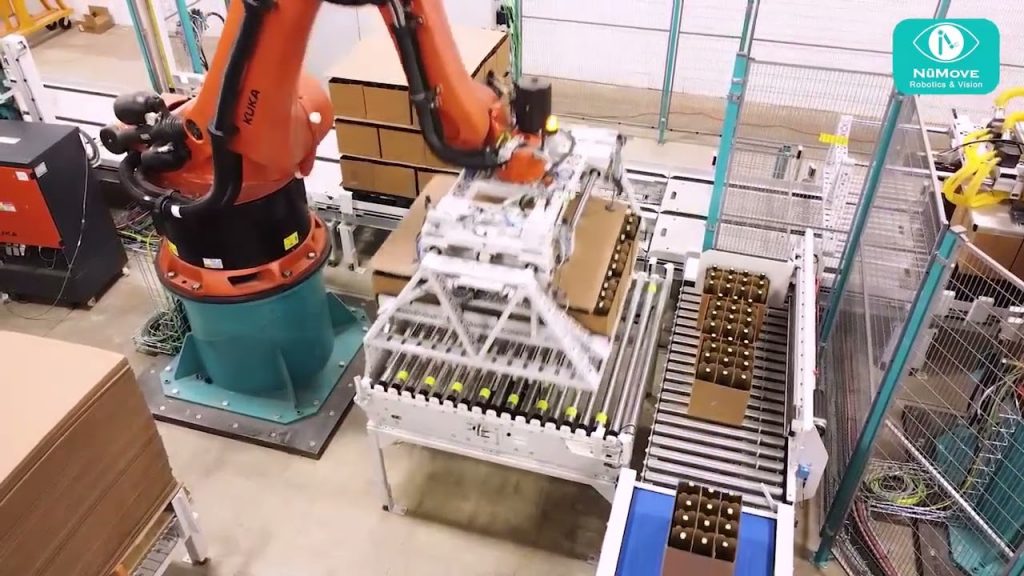Title: Automated Palletizers: Simplifying Case Mix Palletizing and Depalletizing | Robotic Solutions
Description:
Welcome to our video on Automated Palletizers and Robotic Palletizing and Depalletizing! In this informative video, we will introduce you to the revolutionary concept of having a single button that can effortlessly palletize and depalletize your case mix. With easy installation and operation, this system requires no integration or additional equipment, making it a game-changer for businesses seeking efficient palletizing solutions.
[Insert Call to Action paragraph here]
Video Content:
– Introduction: We begin by providing a comprehensive overview of Automated Palletizers, emphasizing their role in streamlining the palletizing and depalletizing processes. We highlight key takeaways, such as the ease of installation and operation, and the absence of integration requirements.
– Operation Steps: Our experts guide you through the step-by-step process of using the Automated Palletizers. From setting up the system to initiating the palletizing and depalletizing functions, we cover each stage in detail, ensuring a thorough understanding of the process.
– Key Features and Benefits: We delve into the various features and benefits that set our Automated Palletizers apart. These include their versatility in handling different case mixes, the efficiency in minimizing manual labor, and the potential for increased productivity and cost savings.
[Insert Call to Action paragraph here]
Additional Tags and Keywords: Automated Palletizers, Robotic Palletizing, Depalletizing, Case Mix Palletizing, Easy Installation, Easy Operation, Efficient Palletizing Solutions, Streamlining Processes, Enhanced Productivity, Cost Savings.
Hashtags: #AutomatedPalletizers #RoboticPalletizing #Depalletizing #EfficientSolutions #StreamlinedProcesses #IncreaseProductivity #CostSavings
Title: A Guide to Getting Started with Robotic Palletizing and Depalletizing
Introduction:
Robotic palletizing and depalletizing have revolutionized the way goods are handled and transported in various industries. These automated systems offer increased efficiency, improved safety, and reduced labor costs. If you are considering implementing robotic palletizing and depalletizing in your facility, this guide will provide you with a clear roadmap to get started.
1. Understand Your Needs:
Before diving into robotic palletizing and depalletizing, it is crucial to assess your specific requirements. Consider factors such as the type of goods you handle, the desired palletizing or depalletizing speed, and the available space in your facility. This information will help you determine the right robotic system for your needs.
2. Research Robotic Systems:
There are various types of robotic palletizing and depalletizing systems available in the market. Conduct thorough research to identify the systems that align with your requirements. Consider factors such as payload capacity, reach, and the flexibility of the system to handle different types of products.
3. Evaluate Integration Options:
To seamlessly integrate the robotic system into your existing workflow, you need to assess the integration options. This includes evaluating the compatibility of the robotic system with other equipment, such as conveyors or warehouse management systems. Consult with experts or vendors to ensure a smooth integration process.
4. Develop a Layout Plan:
Creating a layout plan is crucial to optimize the efficiency of your robotic palletizing and depalletizing system. Consider factors such as the layout of your facility, the flow of goods, and the accessibility for maintenance and troubleshooting. A well-designed layout will maximize productivity and minimize downtime.
5. Provide Adequate Training:
Once the robotic system is installed, it is essential to train your employees on operating and maintaining the system. Training should cover topics such as programming the system, troubleshooting common issues, and ensuring safety protocols are followed. Well-trained operators will ensure the smooth functioning of the system and reduce the risk of accidents.
6. Monitor and Optimize Performance:
Regularly monitor the performance of your robotic palletizing and depalletizing system to identify any potential bottlenecks or areas for improvement. Use data analytics tools to gather insights and optimize the system’s efficiency. This may involve adjusting programming, reconfiguring layouts, or fine-tuning the system settings.
7. Stay Updated with Technology:
The field of robotic palletizing and depalletizing is continuously evolving. Stay updated with the latest technology advancements to ensure you are maximizing the benefits of your system. Attend trade shows, conferences, and engage with industry experts to stay informed about the latest trends and innovations.
Conclusion:
Implementing robotic palletizing and depalletizing can greatly enhance the efficiency and productivity of your operations. By following this guide, you will be well-equipped to navigate the process of getting started with these automated systems. Remember to carefully assess your needs, choose the right system, and provide adequate training to ensure a successful integration. With robotic palletizing and depalletizing, you’ll be well-positioned to streamline your operations and achieve a competitive edge in your industry.Palletizerse
#Started #Robotic #Palletizing #Depalletizing



